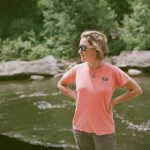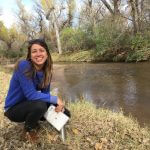Tom Vaughan
Laredo, Texas
Dr. Tom Vaughan is a biologist, educator, and co-founder of the Rio Grande International Study Center (RGISC) in Laredo, Texas. For three decades, Dr. Vaughan has made a sustained contribution to the conservation of the Rio Grande and the Rio Grande Watershed. In addition to founding the RGISC, Dr. Vaughan is credited with creating a water quality data program with the city of Laredo, leading free kayak excursions on the Rio Grande, and preventing the near destruction of Manadas Creek in the early 2000s. Dr. Vaughan also collected 13,000 signatures to save the Casa Blanca wetland.
Tom was recognized as a River Hero at River Rally 2021.
This interview was conducted by Carly Schmidt on January 13, 2020. Learn more about Tom’s work at the Rio Grande International Study Center (RGISC).
Tell me about your history with RGISC and what you’re up to these days.
RGISC was founded by several people, including myself, 25 years ago. I moved to Laredo in 1981 and I had an office at the college campus that was on the banks of the river. I would read the newspaper and listen to the news, and I realized that not many days would go by without some kind of report as to how polluted the Rio Grande was at that time. Eventually, we got together and decided that we would like to know more about the real condition of the river. At that time, we contacted with what was, at that time, the Texas Water Commission, and tried to find out how bad the pollution was. Their response was “we don’t know,” and the reason they didn’t know much about the Rio Grande is because they had no jurisdiction on the river. That fell to the International Boundary and Water Commission, a federal agency. We talked to both agencies and decided that we would monitor several sites on the river.
What motivated you to lead this charge and monitor this stretch the Rio Grande for the first time?
I never really was a water guy, I was always a desert guy. I grew up in the Chihuahuan Desert, went to graduate school in the Sonoran Desert, spent three years in the Sahara, and four years in Kuwait in the Arabian Desert. I didn’t have a whole lot to do with rivers until the early 1990s. I consider myself first and foremost to be an educator, but in order to educate people about anything you need to know something about it. I decided that in order to inform other people I had to get more involved and really try to understand what was happening to the river. It didn’t take long to figure out that the Rio Grande was in serious peril.
What did it look like when you first started monitoring the river?
We wanted to know what the water quality was coming into Laredo–Nuevo Laredo, what it looked like as it passed through the cities, and we eventually had a monitoring site downstream so we could measure data after the river passed through the two sister cities. One of the major improvements to the river would eventually be the construction of the Nuevo Laredo International Wastewater Treatment Plant. At the time we started monitoring, none of the Mexican towns along the border area had a wastewater treatment plant, so all the waste was going directly into the river from the El Paso/Juarez area all the way to the Gulf of Mexico. It made a big difference, but our reports show that even today there’s somewhere around six million gallons of raw sewage going into the river from Nuevo Laredo. We brought the waste from 25 million gallons to 6 million gallons, but the job is far from done.
You’ve worked in so many places, including the Saharan and Arabian deserts. What are some of the unique challenges you face in Texas?
I’ve often said that a lot of bad things can happen to rivers, but one of the worst things is for a river to exist on an international boundary between 2 countries with different standards for pollution and ideas about the way things ought to be controlled. The Rio Grande is a prime example. The real challenge is the raw sewage. Even though it’s coming from across the river, it has completely different regulations and is affecting water quality downstream.
Personally, at the present time, I think the biggest challenge along the Rio Grande is the push to build a border wall, which is going to have devastating effects on the Rio Grande, wildlife, and the people who live along the river. The federal government is in the process of taking private land to build the wall.
You’ve been defending rivers and landscapes for a long time. How does this threat compare to others you’ve faced in your career?
I’d say this threat is certainly top two. Human waste being dumped into the river was a huge deal back when RGISC started, but today we’re facing near-destruction of habitat because of this wall.
You will be awarded the River Hero award at River Rally in San Antonio this year. Among the many wins you’ve had in your career, which are you most proud of?
When I moved to Laredo in 1981, it really was the wild west! There were miles of unpaved streets in this city and development was just starting to take off without any concern for the creeks and tributaries. One of the creeks in Laredo – Manadas Creek – was under consideration for massive development. We were concerned that it was going to be bulldozed. We stopped the destruction of the creek by passing a city ordinance called the Green Space Preservation Ordinance. There was a lot of objection from contractors and developers but we got it passed in 2000. It is so rewarding to see developers abide by this ordinance 20 years later.
An outgrowth of that success was getting the Environmental Services Department formed in the City of Laredo. This department oversees development, as well as water quality protection.
We were successful in getting a mussel species classified as endangered, which is work I am very proud of.
We were also successful in passing a plastic bag ordinance that we worked on for the better part of 10 years. We tried to reduce the amount of plastic that would end up in our creeks and rivers. After any flood event, there would be plastic bags lining the banks and caught up in the riparian vegetation. We eventually got this ordinance passed, but it was overturned by the Supreme Court of Texas. This was very disappointing and we are still in the middle of this fight.
In addition to many wins, you’ve experience a fair amount of losses in this work. What is the driver that keeps you motivated?
Knowing that we have a great team – Tricia Cortez and her staff – that are now driving RGISC’s efforts. Especially with issues surrounding the border wall, it is an uphill battle. People who will be affected by these issues don’t have any real decision-making power.
Is RGISC the organization you envisioned 25 years ago?
We formed RGISC because the five individuals who wanted to get things done on the Rio Grande thought we needed a formal organization to be taken seriously. We thought the organization has to nod to learning about the river, so it has to be a “study center.” It also needs to be collaborative between the United States and Mexico, so “international.” In fact, today, there’s a sister organization in Nuevo-Laredo called Centro Internacional de los Estudios del Rio Bravo (CIER). We envisioned a study center where we could bring people from all over the world to study the river. It has done that in a lot of ways, but RGISC also does so much more.








